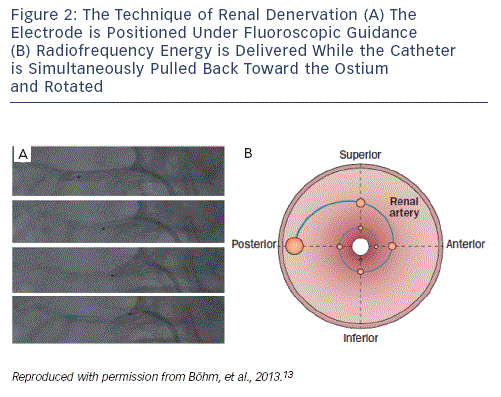Patient Selection
Patient selection criteria should be consistent with those used in the clinical trials, in which eligible patients with resistant hypertension had an office systolic BP >160 mmHg (>150 mmHg in patients with type 2 diabetes), despite treatment with at least three antihypertensive agents, including one diuretic, in adequate doses.9 Single-centre experience has been reported for interventional RDN in patients with mild hypertension.10 However, RDN cannot currently be recommended for the treatment of mild hypertension, or for prophylaxis of hypertension, outside clinical trials.10 Secondary hypertension should be excluded (except for obstructive sleep apnoea syndrome) and patient compliance according to medical treatment should be identified. To define which patients are suitable (diameter >4 millimetres [mm]; length >20 mm) for the intervention, renal artery anatomy must be investigated by duplex ultrasonography or magnetic resonance imaging (MRI)/computed tomography (CT) scan and renal function tests (glomerular filtration rate [GFR] >45 millilitres per minute [ml/min] per 1.73 square metres [mm2]) should be performed to reduce the risk of a decline in renal function following procedural exposure to contrast dye. RDN cannot currently be recommended for the treatment of hypertension in patients with chronic kidney disease outside clinical trials.11,12
Procedure Itself
There are currently six CE-mark renal denervation systems commercially available. The largest experience, although still limited in numbers, exists for the Symplicity system (Medtronic, US). First-generation devices use radiofrequency pulses emitted from a monopolar electrode positioned under fluoroscopic guidance in each of the renal arteries. At least four ablation points per artery are recommended. The catheter is positioned at the periphery of the second order renal artery branch point. Energy (maximum 8 watts [W]) is delivered with an impedance of 250-320 ohm (Ω) to the ablation points. During energy delivery, the catheter is rotated and pulled back to the ostium of the renal artery, to treat the total circumference of the renal artery (see Figure 2). The distance between successive ablation points is recommended to be >5 mm. Operators should be experienced in handling complications, such as renal artery dissection or perforation. Since group C nerve fibres, which carry pain signals, run alongside the sympathetic nerve fibres, the procedure is painful and requires sedation and local analgesia. High-frequency energy delivery also generates heat in the vessel walls. Despite being internally cooled by the high rate of blood flow, heat accumulates in the adventitia of renal arteries where sympathetic nerves are located.13
although still limited in numbers, exists for the Symplicity system (Medtronic, US). First-generation devices use radiofrequency pulses emitted from a monopolar electrode positioned under fluoroscopic guidance in each of the renal arteries. At least four ablation points per artery are recommended. The catheter is positioned at the periphery of the second order renal artery branch point. Energy (maximum 8 watts [W]) is delivered with an impedance of 250-320 ohm (Ω) to the ablation points. During energy delivery, the catheter is rotated and pulled back to the ostium of the renal artery, to treat the total circumference of the renal artery (see Figure 2). The distance between successive ablation points is recommended to be >5 mm. Operators should be experienced in handling complications, such as renal artery dissection or perforation. Since group C nerve fibres, which carry pain signals, run alongside the sympathetic nerve fibres, the procedure is painful and requires sedation and local analgesia. High-frequency energy delivery also generates heat in the vessel walls. Despite being internally cooled by the high rate of blood flow, heat accumulates in the adventitia of renal arteries where sympathetic nerves are located.13
Non-responder
he BP response after RDN differs. Only minor or no changes in BP occur in 8-37 % of patients.14 The reasons for non-response (defined as a reduction in office systolic BP of <10 mmHg six months after the procedure) are not completely understood.
Additional Effects of Renal Sympathetic Denervation
Reduction of sympathetic nervous system by RDN might also show beneficial effects by influencing cardiac arrhythmias,15 diabetes and metabolic syndrome,16 kidney disease17 and congestive heart failure.18 However, the definite role and safety of RDN in these patients needs to be investigated in bigger clinical trials.